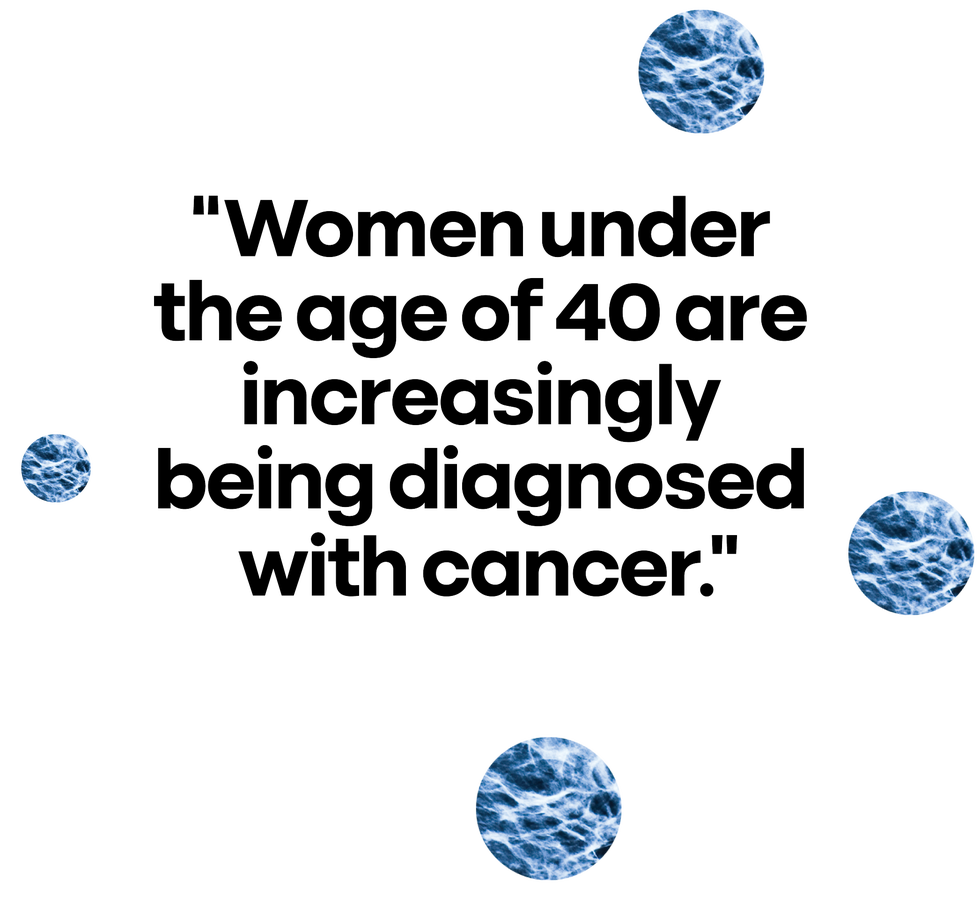Do you know at what age you’re supposed to start getting yearly mammograms? Despite this being a month packed with reminders to schedule your screening, the guidelines on when you should begin making mammograms a part of your annual medical checklist are incredibly unclear. Ask three different doctors when you should start and you may very well wind up with three different answers.
Let’s do a quick recap of the current recommendations from three influential medical groups:
- The American College of Radiology (ACR) recommends that women speak with their doctor about their risk of breast cancer by age 25 and get a mammogram every year starting at age 40 if they’re at average risk.
- The American Cancer Society (ACS), meanwhile, says that women who are at average risk “have the option to start screening with a mammogram every year” from 40 to 44, should get yearly screenings between 45 and 54, and should get one every other year starting at age 55.
- And the U.S. Preventive Services Task Force (USPSTF) now advises that women get a mammogram every other year from 40 to 74.
The USPSTF’s current recommendation is actually a stunning amendment of its 2009 guidance urging women to start biennial screenings at age 50. This independent task force is appointed by the secretary of the U.S. Department of Health and Human Services, and its guidelines help determine what many insurers will cover, says Dorraya El-Ashry, PhD, chief scientific officer of the Breast Cancer Research Foundation.
All this conflicting advice is as baffling for providers as it is for patients. “They’ve left the American public scratching their heads,” says Elisa Port, MD, chief of breast surgery and director of the Dubin Breast Center at Mount Sinai Hospital in New York City.
There’s one thing everyone agrees on, though: As research continues to show that breast cancer is on the rise in young women, screenings should begin earlier for millennials and Gen Z than they did for previous generations. An October 2024 ACS study found that breast cancer rates increased by about 1 percent every year between 2012 and 2021; in women aged 20 to 49, however, they increased faster—by about 1.4 percent per year during the same period.
So what should a woman do? WH sifted through all the confusing guidelines and asked the experts.
Why is there so much confusion around mammograms?
To start, there are a lot of different organizations that provide testing guidelines. The ACR, ACS, and USPSTF are just a few of them—the Society of Breast Imaging, the American College of Physicians, and the American College of Obstetricians and Gynecologists also have their own guidelines, says El-Ashry.
But the main recommendations come from the USPSTF. It’s the driving force behind the guidelines published by government bodies like the FDA and the CDC, El-Ashry says.
The USPSTF is constantly scanning the medical literature to see if its recommendations should be updated, says USPSTF chair Wanda K. Nicholson, MD, MPH. Ultimately, it decided to drop the recommended starting age back down to 40 based on new data on mammography screening and outcomes in Black women, updated models, and epidemiological trends showing an increase in breast cancers in women aged 40 to 45.
The task force also recommends mammograms every other year, not annually—a departure from the ACR and ACS guidelines. “Going from every other year screening to annual screening, you had up to 50 percent more false positives,” Dr. Nicholson says. This recommendation also includes women who have risk factors, such as a family history of breast cancer or dense breast tissue, she adds.
But other groups and individual providers looked at the same research and came to a different conclusion. For example, the ACR emphasizes the current uptick in breast cancer at 40 and recommends starting mammography then, says Stamatia Destounis, MD, chair of the ACR’s breast imaging commission. Yearly screenings are important, she says, because “it’s enough of a time interval to detect a change, but not such a long interval to allow something to grow and become advanced.”
How can I find out if I’m at a higher risk for breast cancer?
Starting at around age 25, women should undergo genetic testing with a geneticist or a genetic counselor to see if they have the BRCA1, the BRCA2, or any other disease-causing mutation that increases the risk of breast cancer, Dr. Port suggests. A positive result for a number of different gene mutations will immediately put them in the high-risk category.
Next, they should have their PCP or ob-gyn do an assessment to analyze their risk.
During that assessment, the doctor might use an online tool that estimates breast cancer risk, like the Breast Cancer Risk Assessment Tool, also known as the Gail model, or the Tyrer-Cuzick Risk Assessment Calculator, also called the IBIS model. The IBIS model is the “most accurate of the many available risk models,” says Wendie Berg, MD, PhD, a professor of radiology at the University of Pittsburgh School of Medicine and Magee-Womens Hospital of UPMC.
Though the tools are available to the public, they should be used with a doctor, Dr. Destounis says, since the results may be difficult to understand.
Factors linked to a higher breast cancer risk include:
- Getting your first period at an early age or going through menopause at a late age
- Never having been pregnant, or having a pregnancy at an advanced age
- A BRCA1 or BRCA2 genetic mutation or any other disease-causing genetic variant that puts you at a higher risk for breast cancer
- Being a first-degree relative (parent, sibling, or child) of someone with a disease-causing genetic variant
- A personal history of invasive breast cancer or ductal carcinoma in situ (DCIS)
- A personal history of lobular carcinoma in situ (LCIS) or atypical hyperplasia
- Radiation treatment to the chest area between ages 10 and 30
- Li-Fraumeni syndrome or Cowden/PTEN syndrome (or having a first-degree relative with either of these syndromes)
- A greater than 20 percent lifetime risk of breast cancer as determined by one of the risk models
- Dense breast tissue
When should I get a mammogram?
If You’re at Average Risk
If your doctor determines that you’re at average risk, experts recommend starting at age 40, though there is disagreement about whether you should get a mammogram every year or every other year.
The recommendations also differ on when you should stop regular testing. The USPSTF says mammography should continue until age 74, while many other organizations say it should stop when life expectancy is less than 10 years or when your doctor determines it’s a good time to end regular screening.
So what should women do? Consult with their doctor about the best time to begin and end regular mammography, El-Ashry says.
“There’s no one-size-fits-all,” Dr. Port says. “That part needs to be individualized.”
If You’re at High Risk
After a doctor determines that you’re at high risk, Dr. Berg says you should find a high-risk program in your area; you can ask for a referral from your breast imaging radiologist. Many major cancer centers—like Mount Sinai’s Dubin Breast Center in New York City or UCLA’s High Risk Breast Clinic in Santa Monica, California—have programs specifically designed for high-risk patients.
The program will then determine what kind of specialist you should see—it could be an oncologist, a breast surgeon, or an ob-gyn with a special interest in risk assessment and high-risk screening—who will discuss with you prevention options (like medication or surgery) and when to begin mammograms, Dr. Port says. She adds that the doctor will then set up any necessary follow-up appointments—like a yearly MRI in addition to a mammogram, for example.
“We do all the behind-the-scenes work,” Dr. Port says. All the patient has to do is show up.
If you’re at high risk, you will likely need to begin regular screenings younger than 40. For example, if a woman at high risk has a close relative who was diagnosed with breast cancer, “a general rule is to start screening high-risk women 10 years prior to the age of that diagnosis, but not before 25,” Dr. Berg says. “If a woman’s mother was diagnosed at age 45, then it’s reasonable to start screening at age 35.”
When should I advocate for more than a mammogram?
If You Have Dense Breasts
Nearly half of women 40 and older have dense breast tissue, according to the National Cancer Institute. Not only are women with dense breasts at higher risk for breast cancer, but those cancers are also more likely to be overlooked. For women with the densest breasts, 40 percent of breast cancers are missed on mammograms, Dr. Berg says.
The only way to find out your breast density is to get a mammogram. And thanks to a new FDA rule, all mammogram reports now tell patients whether or not they have dense breast tissue.
If you have dense breasts and are not otherwise at high risk, you should discuss having a yearly MRI or ultrasound with your doctor, Dr. Berg says. (If you don’t have insurance or the additional scans aren’t covered, your out-of-pocket cost might range from about $300 to more than $1,000, BreastCancer.org reports.) If you have dense breasts and are also at high risk due to a genetic mutation or other factors, you should have a yearly MRI in addition to your mammogram, she adds.
For women with dense breasts, there is not yet enough evidence for the USPSTF to recommend for or against additional screening with a breast ultrasound or MRI, which means insurers have no basis to provide full coverage for these additional tests.
And that leaves “a big gap in practice” for those with dense breasts, Dr. Berg says. “It still falls on individual radiologists, individual physicians, and patients themselves to recognize, ‘Hey, I’m at higher risk. I should be getting more screening.’”
If You’re at High Risk
In addition to regular mammograms, you’ll need other screenings—like an MRI or a whole-breast ultrasound—if you’re at high risk for breast cancer. But the exact frequency will depend on your personal risk factors, Dr. Port says.
A combination of mammogram and MRI finds the most cancers, so women should advocate for regular MRIs if they’re at high risk, Dr. Berg says.
Meet the experts: Stamatia Destounis, MD, chair of the American College of Radiology’s breast imaging commission. Elisa Port, MD, chief of breast surgery and director of the Dubin Breast Center at Mount Sinai Hospital in New York City. Wanda K. Nicholson, MD, MPH, a professor of prevention and community health at the Milken Institute School of Public Health at the George Washington University and chair of the U.S. Preventive Services Task Force. Wendie Berg, MD, PhD, a professor of radiology at the University of Pittsburgh School of Medicine and Magee-Womens Hospital of UPMC. Dorraya El-Ashry, PhD, chief scientific officer of the Breast Cancer Research Foundation.
Charlotte Walsh (she/her) is an associate news editor with Women’s Health, where she covers the intersection of wellness and entertainment. Previously, she worked as a writer at The Messenger, E! News, and Netflix. In her free time, she enjoys reality television, tennis and films starring Nicole Kidman.







